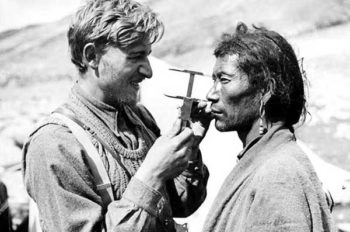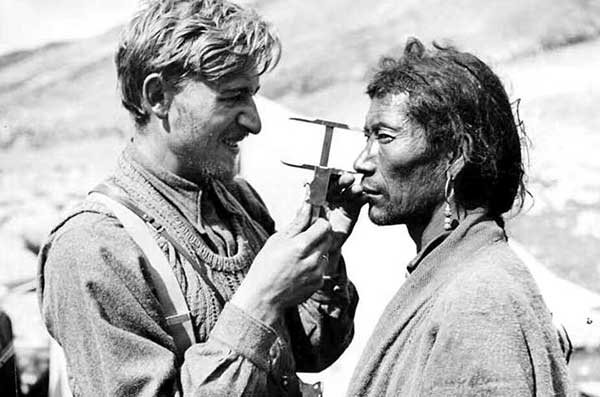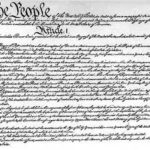Let’s Talk About Race and Racism. Part 5: Scientific Racism
This post was supposed to be about white supremacy, but there’s something that we need to discuss first. Scientific racism.
Indroduction
First, let’s orient ourselves to the subject a bit–as this series has already shown, the belief in races as we know them simply didn’t exist in the ancient world–which doesn’t mean that ancient writers didn’t show their preference for themselves over others or engage in stereotypes about various ethnicities. But it means they had no concept of European, African, Asian or other sweeping generalizations about all of humanity that we call “races.”
I’ve already mentioned in a previous post the late Middle Ages had begun to think of Shem, Ham, and Japheth as being the fathers of Asians, Africans, and Europeans (though the Bible doesn’t show them so neatly divided by place), so that was the proto-racial concept Europeans started out with, one not entirely well developed or thought about all that much, at the beginning of the scientific revolution that began a bit before the Enlightenment.
Racism in Science
Hey, the ugly truth is that early science–some might want to dismiss it as “pseudo-science,” which is only somewhat fair–is what created racism.
But wait, didn’t I say in a previous post that slavery created racism? In fact, I was a bit inconsistent in my terminology. Yes, slavery created a racial bias against the people held in slavery, just as the reality of fighting Native Americans created a concept of the person being fought, the “Indian.” These realities created biases, but biases themselves were not enough to create the idea there exist races of humans that span the globe.
My previous posts have had the purpose of showing the order of actual events, which is different from what many modern people presume. Racist Europeans did not set out to enslave Africans because they believed they were inferior. The order of events was actually that the first indentured servants from Africa were in Colonial America in 1619. Slavery didn’t beome legal until 1661. The first Enlightenment treatise to use the word “race” came out in 1684. But scientific explanations of race didn’t begin to be systematically dismissive of non-European races until 1799.
First came economic exploitation, then legal discrimination, then came the scientific system of what I called “early racism” in my previous post, then came de-humanizing “scientific” systems of racism.
Over time, such scientific (or pseudoscientific) systems would increasingly argue in favor of justifying slavery and colonialism. But at first, they were more intrested in simply explaining where humans of differing types came from.
Note that as they created their theories, these philosophers and scientists wrote during an era of European de facto dominance over all sides of the Atlantic (and increasing power elsewhere). But the theories were produced in the name of science–of advancing knowledge and understanding. And in fact, without the urge to classify and categorize on a global scale, we would not have racism at all. Racism is a product of the science of the past.
Just to be clear, I am not anti-science. Science can be a very good thing. But it is subject to abuse, as is any human-weilded power. The urge to classify in a scientific way was key to creating a sense that “races” are real and really matter. Which was key to seeing some races as inferior to others. But that science didn’t happen in a vacuum.
Note in addition to the influence of slavery and colonialism I already mentioned, the discovery of non-European lands fed into science in ways it’s hard for a modern person to appreciate. New lands, new animals, new plants, new products of unfamiliar civilizations, and yes, unfamiliar human beings, all spurred on an already-developing urge to classify and analyze. The very notion that there are “races” that span the globe and define all human beings was invented during the Enlightenment and was perpetuated in the name of science–and is still justified by science to a small degree up to the present.
Monogenism Versus Polygenism
Let’s define an important pair of terms in the context of human origins. A “monogenist” holds that all human beings come from a common source. A “polygenist” says human beings sprung up from separate, unrelated sources.
Generally, monogenism is less favorable to seeing races as completely different than polygenism. Yes, the monogenist has to answer the question of where other so-called races come from, if all races started as one. Sometimes the explanations of how other races came to be are pretty insulting to non-Europeans–oh and let’s be clear here: Just as Europeans should get the credit for creating modern science (sure, based on antecedents derived in part from other cultures, including Islamic and Chinese culture), they should also get the blame for creating racism.
Polygenism was the position of people who had the harshest condemnation of other races–because they claimed the non-European races were not as human. Though in fact, some polygenists saw non-European races in relatively benign terms. The details get complex.
The Bible is staunchly monogenist about human origins. Modern science is monogenist, too, though that wasn’t always the case. Note a minority of modern scientists still defend polygenism.
Some Key Racial Thinkers During the Enlightenment
Francois Bernier gave us the first essay that first divided human beings into races in 1684. He counted all Europeans, West Asians, North Africans, and Native Americans as one race, Sub-Saharan Africans as another, East Asians as another, and the Sami/Lapplander people of Scandinavia as a 4th. His system roughly followed the Japheth, Ham, Shem division of three races, with some weirdly savage attacks on Sami people as half-animal added on, talking about them as being worse than any other race…a strange opinion that no other racial theorist continued after Bernier.
Robert Boyle (1627-1691), better known as an early chemist, argued common descent from Adam and Eve and unity of the human race.
Richard Bradley in 1721 wrote the Philosophical Account of the Works of Nature in which he argued for 5 races. White Europeans with beards; white men in America without beards (meaning native Americans; men with copper color skin, small eyes and strait black hair (Asians); blacks with strait black hair, and blacks with curly hair. He did not set a specific heirarchy among the races.
Georges-Louis Leclerc, Comte de Buffon (1707-1788) was a monogenist. He held to a degeneration theory. That is, all races where once white, but a variety of environmental factors changed them to other colors. In particular, he believed the harsh sunlight in Africa turned black people dark. He actually believed that given the right environmental conditions, people of other races would revert to being white…which is a sentiment that definitely put Europeans on the top of an order of races, assuming Europeans are the default for “human” and everyone else is abberant. But his system did not assume inferiority of other races.
In his 1734 book Sketches on the History of Man, Scottish lawyer Henry Home, Lord Kames (1696–1782) was the first major figure to argue as a polygenist. He believed God had created different races on Earth in separate regions. That there were co-Adams that God created that simply are not mentioned in the Bible (note that this isn’t too different from how I imagine God could have created aliens…).
The book is mostly about a belief in developing human progress over time, human cultural evolution. Kames assumed humans are continually getting better, improving, that there is a natural movement, a “progress” of the human race that starts at hunter-gatherer, moves up to herdsman, then develops agriculture. In his system, Native Americans of the North America were at the bottom of the development chain, Africans were at the herder stage, and Europeans and Asians were at the advanced stages.
The idea that whatever is coming in the future is good and progress is inevitable probably was more influential that Kames’s ideas on race–certainly modern Progressives tend to see society as getting better and better, which it doesn’t really do if you ask me.
I’d like to quote Kames extensively–even though I disagree with much of what he said, I find it interesting. But space doesn’t allow me to. He spends a great deal of time explaining why after all, Scottish people Are The Best Ever, echoing ancient world ethnocentrism even as he hammered out new racial theory. He did consider black people to be inferior, we should note, but his polygenism was relatively benign compared to what would come later.
Carl Linnaeus in 1767 came out with Systema Naturae, the base document of modern biological science, the one that laid out the system of order, genus, and species all science uses today. He divided humans into four races (four varieties), influenced by ancient world theories of four humors. He said there were 4 races dominated by 4 humors. Americanus—choleric, Europeanus—sanguine, Asiaticus—melancholic, Africanus—phlegmatic. His system is kind of discriminatory because of a preference for being sanguine, but treated all humans as human.
Benjamin Rush (1745–1813), was a signer of the US Declaration of Independence and a monogenist. He believed being black was caused by an inherited skin disease that could be cured over time. He was against treating black people badly, but was also against spreading the disease via interracial marriage. We’d say that was racist and it literally was racist–but it was not the sort of racism that justified slavery or considered black people sub-human.
Samuel Stanhope Smith (1751–1819) was an American Presbyterian minister. His essay on the Causes of Variety of Complexion and Figure in the Human Species in 1787 argued in effect black skin is a sort of giant freckle and no indication of significant racial differences. Which by explaining black people as defective somehow certainly is racist in a way–but it is literally true that a natural darker spot on a white person, a freckle, is a place with more melanin, and having more melanin defines darker-skinned people. So Smith was actually correct in identifying what makes some people darker than others.
Post Enlightenment Racial Thought (Increasingly Hardcore Racist)
Charles White (1728–1813), 1799 Account of the Regular Gradation of Man, produced the first of what I would consider a genuine racist theory. He was a polygenist. He gave the first clear and unambiguous argument that whites and Negroes were separate species and Negroes were inferior by nature. He actually argued, long before Darwin came around, that Africans descended from gorillas–as opposed to white people, who did not. Yeah, that horrible, horrible idea. It came from this guy.
Christoph Meiners, polygenist, held to a multitude of races in which Slavs were not considered fully European and Celts were the noblest race. Weirdly Meiners was German and not Celt, so he defied the rule of standard ethnocentrism. He made lots of sweeping racial generalizations about black people, Indians, Middle Easterners, ranking them in order. His most important book was the 1815 Outline of the History of Mankind.
Rev. Richard Furman in 1822 published his Exposition of the Views of the Baptists Relative to the Coloured Population of the United States. He used the Bible to defend slavery and was in fact a monogenist who conflated the curse on Canaan into a curse on Ham. And since Africans are decendants of Ham in his view, they were worthy of slavery. His work was a hugely popular in the pre-Civil War South. Note that he personally was anti-slavery as an impoverished young man, but then became wealthy and a slave owner, then flipped to becoming an apologist for slavery after it was making him money personally. I’m not making that up.
Georges Cuvier (1769–1832), the French naturalist and zoologist, influenced scientific polygenism and scientific racism. Cuvier believed there were three distinct races: the Caucasian (white), Mongolian (yellow) and the Ethiopian (black). He did believe they were distinct species, but didn’t rank them in order as far as I know. Still, the idea that humans represent separate species is damaging all by itself.
In Crania Americana (1839) Samuel Morton contributed to the new science of “Craniometry” and argued for racial superiority based on brain capacity. He argued white brains are the biggest, Negroes are smallest, and Native Americans are in the middle. His results have been shown faulty in modern times–besides, among humans the exact size of your brain is not directly linked to intelligence, baring diseases in which a significant portion of the brain is missing.

Measuring skulls…Image source: Socialistworker.co.uk
Diseases and Peculiarities of the Negro Race by Samuel Cartwright (1851), argued slaves only ran away because of “Drapetomania”—that healthy black people enjoyed being slaves and they had to therefore be mentally ill if they wanted to escape. Like Furman, his work was hugely popular in the antebellum South.
Arthur Schopenhauer (1788–1860), better known as a philosopher on other matters, argued the “white races” were superior because they had to work hard to survive rigorous Northern climates. Though he admired the ancient Hindus and Egyptians.
An Essay on the Inequality of the Human Races (1855) French aristocrat and writer Arthur de Gobineau (1816–1882), argued for complete white supremacy. Proposed 3 races, white, black, and yellow, and said if any black or yellow man had intelligence, it was because of interbreeding with white people. Believed interracial marriage would mostly dilute white superiority and destroy civilization. He directly argued that white people needed to suppress other races.
Note that Charles Darwin’s Origin of the Species came out in 1859. And while I do blame Darwinism for a number of ills in modern society, Darwin himself did not specifically address the issue of human races in his signature book and when he did talk about it in later writings, he was not himself a hardcore racist. But Darwinism added fuel to the racial theorists fires. Because prior to this time, polygenism was broadly attacked by the Bible-believing public as not consistent with the Bible–and polygenism was the idea most supportive of racism. Though of course there were racist monogenists like Furman.
After Darwinism, the racial theorists felt increasingly unencumbered to really pour out more and more racist ideas.
Post-Darwinist Racism
Clémence Royer who could perhaps be seen as a feminist icon, also was a racist. In translating the Origin of the Species into French in 1862, she wrote a preface that the races are “not distinct species” but “quite unequal varieties.” She claimed that natural selection made it clear that “superior races are destined to supplant inferior ones.” In effect, she applied Social Darwinism to racial theory. Because species survive based on being more competitive, clearly Europeans are superior to other types of human beings, because these particular human beings were demonstrating superiority by conquering other peoples around the world. (Note that in his book The Descent of Man in 1871, Darwin would combat how his theory was taken to justify racism by arguing for monogenism.)
Carl Vogt (1817–1895) in his 1864 book Lectures of Man he claimed the differences between white people and “Negroes” are greater than those between two species of ape. That supposedly proves that Negroes are a separate species from whites.
Georges Vacher de Lapouge (1854–1936), a theoretician of eugenics, who published in 1899 L’Aryen et son rôle social (1899 – “The Aryan and his social role”). In this book, he classified humanity into various, hierarchized races, spanning from the “Aryan white race, dolichocephalic,” to the “brachycephalic,” “mediocre and inert race, best represented by Southern European, Catholic peasants.” Between these, Vacher de Lapouge identified the “Homo europaeus” (Teutonic, Protestant, etc.), the “Homo alpinus” (Auvergnat, Turkish, etc.), and finally the “Homo mediterraneus” (Neapolitan, Andalus, etc.) Jews were brachycephalic like the Aryans, according to Lapouge; but exactly for this reason he considered them to be dangerous; they were the only group, he thought, threatening to displace the Aryan aristocracy. Vacher de Lapouge became one of the leading inspirators of Nazi antisemitism and Nazi racist ideology. (Note how the category of “white” is getting smaller in 1899 that it had been before–contrary to what Critical Race Theorists say.)
Madison Grant (1865–1937) adopted the three-race European populace model, but transliterated la race nordique into “The Nordic race” based upon his racial classification theory, popular in the 1910s and 1920s. Madison Grant’s The Passing of the Great Race (1916) as “the most influential tract of American scientific racism” according to Stephen Jay Gould.
Lothrop Stoddard published many books against what he saw as the peril of immigration, his most famous being The Rising Tide of Color Against White World-Supremacy in 1920. In this book he presented a racist view focusing concern about the coming population explosion among the “colored” peoples of the world and the way in which “white world-supremacy” was being lessened in the wake of World War I and the collapse of colonialism. Nordic, Alpine, and Mediterranean were European sub-groups he used, with Nordic being the highest.
Why Worse and Worse?
Note there are a lot of post-Darwin racists I didn’t mention. So many–many of who favored eugenics, getting rid of bad genes. For them, the genes of other races…but still, even with what I included, it’s not hard to see that scientific and pseudo-scientific racist theories became harsher and harsher over time and as a general rule, created more categories, though of course there were exceptions to the rule.
Why?
I think I already said why in my last post. As the concept of universal human rights became more popular and more accepted, how could a person justify their position at the top of a pyramid of power? Racial theorists justified it by inventing systems in which a world-wide system of races exist and upon which their particular group sat at the very top of the order. The order was supposedly meritorious. “Nordic” white people are the most dominant because they are racially superior. Anyone else is inferior, by degrees that cut across Europeans to all peoples in the world, putting Africans at the very bottom.
But note Europeans had the power first–then they justified it. And even as some Europeans were justifying their power with racial theories, other Europeans firmly held to the monogenist idea that all humans have a common origin. That “all men are created equal.” Even while at the same time racial theories became increasingly hateful and exclusionary.
What Stopped This?
The Nazis were the result of the radical racial theories of their time–theories that were not necessarily German. They carried out what the extreme racists believed…and most people, all around the world, reacted in horror to the results radical racism produced. Thank God.
So the excesses of the Nazis convinced most people they were wrong, that all racism was wrong. Not that racism is dead, but it has changed and I doubt will ever be the same. Again, thank God.
Conclusion
So were you aware of the arc of “scientific” racism? That it generally got worse and worse? That Darwinism added fuel to the fire? That it was not in fact common to say some people of European descent are not actually white until after 1850s or so?
What are your thoughts on this subject?










































I knew the general arc of racism/scientific racism, but I didn’t really know many of the names involved in the research. After the horrors the Nazis committed, I can certainly see how many people would realize racism is wrong, but I doubt that was the only thing that turned the tide against racism.
The Nazis definitely spelled the end of most of what we could call scientific racism. In academic circles, claiming any one race is superior to others is immediately rejected. That began after WWII–not to say there were not anti-racists prior to WWII, but the post-war world no longer had any tolerance for the racist side of the debate.
On occasion, some modern academic will claim that race really is important in a way–that one race is more intelligent than others, for example. But saying such things is a quick road to pariah status in modern times. And why was the change in academia so enormous (because things didn’t used to be that way)? Pretty clearly the Nazis.
But did the reaction to the Nazis destroy all racism, as opposed to all scientific racism? Agreed, the Nazis were not as important there. Though they did give all racists a massive black eye.
Yeah, I was thinking about racism in general when I made my comment, not scientific racism specifically. Sorry about that.
I still think that “race” is a more fluid concept than you give it credit for.
You seem to be operating under the sense of scale for races that falls more in line with the 3 types along the lines of Cuvier, which, as you note, is a later idea (tho one of the earlier later ideas). Which would mean that you’re also projecting a definition of race on the pre-Enlightenment era that may be as equally anachronistic as you claim the CRTs of being.
Like, you’ve been consistently representing the only “real” racism is this later one with scientific claptrap attached. As if it isn’t “real” racism if it isn’t on the scale of Cuvier’s or Linnaeus’s system.
I’m sure I can come up with some horrible analogies that don’t make sense to anyone else, like if you were talking about the development of knitting without taking into account nalebinding, or somehow not considering nalebinding to be “real” needlework because it can’t really be done by machine. And what that might mean for crochet because crochet can’t be done by machine. (I told you this was a horrible analogy)
It’s hard to tell a story that spans thousands of years without simplification. Well, impossible, actually. That I have simplified is true. But the question is if my simplifications are in the spirit of the actual picture–and that actual picture is of race becoming increasingly important in American and European thought up through the early 20th Century. As opposed to being important from day one.
To back up my ideas concerning what early Americans thought about race, there are Medieval references to Shem, Ham, and Japheth distributed over the world that I didn’t quote. I did quote the US Constitution and US Declaration of Independence and have noted, correctly I think, that the legal status of “white” referred to a person who could not be enslaved, who also was not an “Indian.” I also showed that in early Colonial America, both Africans and Europeans were held in indentured servanthood. Slavery came some decades later–and came to be justified later still–though it already existed in Spanish and Portuguese colonies. Why was that? I offer an explanation.
I did some specific research after the post before this one and found info on the 1790 immigration act, which I edited back into the post. The act mentions only white people could become citizens. This would be repealed by the 14th Amendment for everyone except Indians, who were granted US citizenship on a tribe by tribe basis until 1924, when Congress passed a law declaring all American Indians living in the territory of the USA as US Citizens.
There were a series of court cases in which non-Europeans sued to be considered white between 1790 and 1860. The courts at times ruled Syrians were white and at times ruled Syrians were not white. A Sikh applied for citizenship, apparently in part based on his light skin and blue eyes. The court ruled he was not white because he was not a Christian. This tells me that in a sense, the sense of race was not “fluid” as you call it, but ill-defined. But why ill defined? Because the sense that being white is something specific and we all know what that means was cooked up by racial theorists later on. Early in America, “white” was “not black” and “not Indian,” that is, defined by reactions to people definitely perceived as “other.” But without a clear positive meaning, not until later.
But the animosity Europeans felt towards one another, Europeans of other nationalities, still existed anyway. Class discrimination existed anyway. Race was not the yardstick by which all things were measured, not at first.
Critical Race Theorists, from what I have read, hold a number of principles, but two of the most important are 1) Racism is permanent. I.e. it has always defined our society and in fact always will (though its effects can be mitigated to a large degree). 2) Racism is central–it isn’t something that happened on the periphery of society, it instead is at the very core of what our society is.
These sweeping generalizations about race and others made in recent times have convinced some people, but others detect overreach and in effect wind up becoming more dismissive of racism than they would be if not exposed to CRT. In this regard, CRT is increasing racism among some people. In my opinion, of course (but an opinion I can back up in specific ways).
That’s why I feel CRT needs to be corrected. The most important correction: 1) Racism is not permanent. It was invented by a specific civilization at a specific time. Because it was created by humans, it can be dismantled by humans. And a second correction would be 2) Racism was not always central. Yes, it became central and still profoundly affects many things. But because it wasn’t always central, it can be removed.
But these posts do not just criticize CRT. They will also run against claims there is no truth to systemic racism. There in fact has been systemic racism and there still is. Racism still is a major feature of our society and is a factor in the different outcomes of different races. It’s not the only factor and mostly isn’t the main factor–its importance in fact is a variable and not a fixed quantity, with a person’s family status being the most important predictor of future success. But race is also a factor–so racism, even systemic racism, should not be poo-pooed just because the CRT crowd gets a lot of things wrong.
?? I’ve never seen that CRTs claim that racism is permanent. Pervasive, yes. But I guess I can see how you arrived at “central” because of our differences on how “systemic” works.
…..Unless by “permanence” you’re referring to the meme about how Black people can’t take off their signifiers at the end of the day like cops can. People perceived as white can transcend their birth status with the application of enough money, but there have been too many instances of Black people getting pulled over for driving “too nice” cars or getting the cops called on them because they’re going into “too nice” of a house (that they live in).
Only somewhat relevant link: https://www.wonkette.com/trump-gonna-make-all-the-kids-as-stupid-about-history-as-dinesh-dsouza
Well, the actual statement by CRT thinkers is “white supremacy is maintained over time.” Couple that with the common thinking about inherent bias and a lack of any vision of a world without racism (in contrast to MLK Jr’s “I have a dream” speech), I think seeing racism as “permanent” is not an unfair characterization CRT.
“Central” I got directly from CRT definitions. See Wikipedia on this:
https://en.wikipedia.org/wiki/Critical_race_theory
Notleia, do you mean that the definition of race has been fluid through history, or that the concept itself is more broad than how Travis is defining it, or something else?
Both.
I think the animosity between, say, Slavs and Croats could be a form of racism even if it’s broadly considered white-on-white violence.
IIRC CS Lewis had a more academically-focus book about some of the medievalist etymology about words like “kind” (I don’t remember “race” being in there, but “kind” a similar but weirder journey).
So coming at it from a linguistic angle, because the usage of the word “race” or “kind” was hella murky in the past, the conceptus of what “race” or “kinds” of people must also have been hella murky.
I suppose it depends on each person’s intended definition of “racism,” more than anything else. Meaning, if you define racism broadly and say it existed all these years, you could be correct. But if Travis is defining it differently and saying it didn’t exist all these years, he could also be correct. My guess is that you define racism differently than I think of it, which I suppose would be basically, “prejudice, discrimination, or antagonism directed against a person or people on the basis of their membership in a particular racial group.” So, because Person A is White or Jewish or Black, they are less worthy, should be discriminated against, or antagonized. A central necessity to the definition of racism that I intend when I use the word is that the person committing racism is doing it because of a belief that one race is superior to another. I think a very specific definition of racism is important for a number of reasons. The word gets thrown around a lot these days in bizarre ways, to the point where it’s almost a catch-all for any sort of disparity of life results between different racial groups. Which… is counter-productive. Because fixing an issue demands specificity. A bandaid doesn’t fix a sliver. A tweezers doesn’t fix a third-degree burn. So let’s not call all skin wounds slivers or burns. In the same way, disparity of life results between racial groups is caused by a boatload of factors, so being specific about each of those factors and exactly how they contribute (and how to fix them) is necessary to solving the issues. Wasn’t that the original goal of CRT and the reason for why they came up with the term systemic racism? (Which, I agree with Travis that the term unveils something real that previously was pretty much ignored or not thought about–although the extent of it is, of course, debatable, even within CRT circles.)
You haven’t really done anything to convince me that the actual processes for fixing racism is different than those for fixing, say, sexism or classism, et al.
Come to think of it, I dunno that you actually have concrete ideas or policy ideas for fixing racism, especially when you don’t seem to believe in the systemic nature of current American racism and seem to think it’s only a matter of a few errant bunghole individuals. Like, what do you have that’s different from the mainstream Democratic Party platform? Do you even approve of changing zoning laws to allow du/triplexes on zones traditionally only occupied by single-family housing? (That’s a specific NIMBY piece of bullcrap that I do not understand the pearl-clutching over.)
Once again, you ignore what I actually wrote. Of course there’s systemic issues that need to be fixed. Like access to quality schooling, and food, and mentorship for at-risk youth. The fix for being born into poverty is much different from fixing policies built on racism. Reverse Jim Crow and you still have poverty. I shouldn’t have to convince you of basic reality, Notleia, and honestly, I don’t have the time or the patience. IDK what the exact fix would be for the million or so issues that contribute to unequal life outcomes because I don’t specialize in those sectors, and it hardly matters what I think as a result, but I give from my personal income toward non-profits that DO specialize in addressing specifically schooling, food, and mentorship for at-risk youth – particularly black youth.
So, what do you do?
But how does it effect racial relations if poverty were reversed? It wouldn’t be completely solved, but it would be mitigated. MLK thought so, too.
But if you want to make judgmental sounds about where I throw my money, I support the Land Stewardship Project, which has both environmental and economic goals for sustainable land use (which prioritizes the small family farmer). So maybe I don’t give people fish or teach them to fish with my tiny charitable funds, but I’m trying to make the lakes and riverways sustainable for future fishing in this somewhat tortured metaphor. Long-term sustainable planning makes economic sense, too. And I still have my yarn projects for more personal types of charity.
The government won’t (and can’t) magically fix everything. So, my ideas on how to fix things is that we help those in need.
“But how does it effect racial relations if poverty were reversed?” You just proved my point.
“Government won’t magically fix everything” is an exaggerated version of an assertion that you treat as axiomatic but, in fact, is not.
Learning about things is different from believing in those things, so I’m baffled by your unwillingness to do something as simple as play with them as hypotheticals.
I’m tempted to throw out more progressive ideas if only to see if anything makes a dent in your antiprocess circuits, but that’s probably going to take a lot more effort than I actually want to put in it.
Every time I write something, you assume I mean something I don’t. Is that on purpose? Or am I just doing a bad job explaining myself? (honest question)
PS: I totally get that not everyone can give. You certainly can’t give to everything, either. It was more a rhetorical question in answer to your insinuation that what I say holds no weight because, in your opinion, I may have nothing to offer.
This is a fascinating article! I appreciate the historical perspective, and will doubtless refer to this series again.
Thank you!